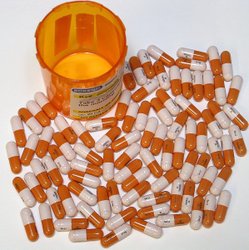Adderall
Adderall® CII is a pharmaceutical amphetamine used to treat attention-deficit hyperactivity disorder and narcolepsy. It was first prescribed in the 1970s as an anorectic (under the brand name Obetrol®), but such usage is now rare. more...
Use
Adderall is a central nervous system stimulant composed of four amphetamine salts: amphetamine aspartate, amphetamine sulfate, dextroamphetamine saccharate, and dextroamphetamine sulfate (the last salt is also prescribed alone as Dexedrine®). The four component salts are claimed to be metabolised at different rates.
The average elimination half-life for dextroamphetamine is 10 hours in adults, and for levoamphetamine, 13 hours. Its effects are otherwise similar to other central nervous system stimulants (see amphetamine for details.).
The manufacturer claims that the mixture of salts makes Adderall's effects smoother, with softer highs and lows, than those of other treatments for the same disorders.
There is little evidence, however, to support this claim for immediate-release Adderall. A recent patent application for Adderall (USP #6,384,020) was a pharmaceutical composition patent listing a rapid immediate release oral dosage form. No claim of increased or smooth drug delivery was made. A recent double-blind, placebo-controlled crossover study, conducted among children, indicated that Adderall behaved similarly to other immediate release amphetamines. The authors found that sustained-release dexamphetamine (the main isomeric-amphetamine component of Adderall) had a longer duration of action, and cost less than Adderall, though dexamphetamine was less effective in the first few hours of morning dosing.
Adderall is now sold in either an immediate-release tablet or an extended-release capsule, marketed as Adderall XR. Doses for both immediate-release and extended-release form come in 5mg, 10mg, 15mg, 20mg, 25mg, and 30mg increments.
Adderall XR utilizes the Microtrol® delivery system to achieve the extended-release mechanism. This delivery system incorporates two beads: the first type of bead dissolves immediately and the second type releases four hours later. Maximum plasma concentration is achieved in seven hours, compared to regular Adderall IR (immediate-release) which reaches maximum plasma concentration within three hours. As a result of its high bioavailability, Adderall XR's effectiveness is not altered by food absorption in the GI tract. However, tmax (mean plasma concentration) is prolonged by 2.5 hours (using a standard high-fat meal as the control). Acidic beverages should not be taken with Adderall XR as they alter the pH balance of the stomach.
Effects
While the exact mechanism is unknown, it is believed that Adderall works by blocking the reuptake of dopamine and norepinephrine into the presynaptic neuron and increasing their release from the presynaptic neuron into the extraneuronal space. In other words, Adderall reverses the reuptake mechanism, turning it into a pump instead of a vacuum.
Read more at Wikipedia.org



